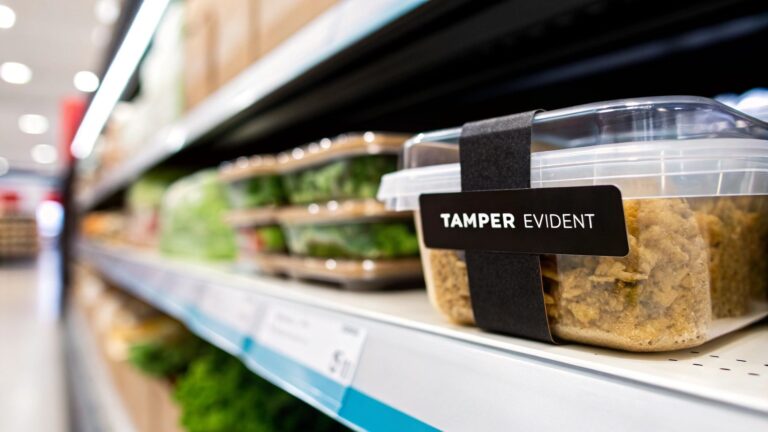Why Tamper Evident Food Packaging Matters Now
The food industry must address rising concerns about safety and hygiene. Consumers care as much about package integrity as they do about what’s inside. Tamper evident food packaging has moved from a nice-to-have feature to a consumer expectation.
Shifting Consumer Expectations
Customers today research products and demand clear evidence that their food hasn’t been opened. They look for:
- Visible seals or stickers that break on opening
- Date stamps and batch codes for traceability
- Clear messaging about package integrity
Historic events—like the 1982 Tylenol tampering crisis—show how a single incident can reshape trust and drive innovation in packaging across industries.
The Business Impact Of Tamper Evident Packaging
Brands that adopt tamper-evident solutions showcase their commitment to safety and build stronger relationships with buyers. This leads to:
- Increased market share as cautious shoppers choose trusted labels
- Higher brand loyalty is driven by repeat purchases
- Secure delivery options that protect food during transit
A quick look at market figures highlights this growth:
| Year | Market Value (Million USD) | CAGR |
|---|---|---|
| 2024 | 1,905.7 | |
| 2035 | 2,775.4 | 3.6% |
The food and beverage sector makes up over 35% of this market.
Turning Security Into A Marketing Advantage
Forward-thinking brands turn safety features into a selling point. Well-designed seals and tear strips:
- Reinforce quality messaging on the shelf
- Integrate logos and brand colors for instant recognition
- Give consumers a clear signal of protection
This approach not only strengthens visual appeal but also deepens trust with every unbroken seal.
The Future Of Food Safety
Adopting robust tamper-evident technology is a smart business move, not just a safety measure. Investing in these solutions builds consumer confidence, safeguards brand reputation, and sets the stage for lasting success.
The Definitive Guide to Tamper Evident Packaging Solutions
This image highlights several common seal types used in tamper evident food packaging, particularly showcasing a jar secured with both a tear strip and an induction seal. Using multiple layers of tamper evidence, like the combination of a tear strip and an induction seal, offers greater security and builds consumer confidence.
Effective tamper evident packaging isn’t just an afterthought; it’s a crucial part of your brand’s commitment to safety and quality. Let’s explore the diverse world of tamper evident food packaging solutions and discover how they can strengthen your brand.
Types of Tamper Evident Solutions
A broad range of tamper evident features are available for food packaging, from simple and affordable options to more sophisticated solutions. This variety ensures there’s a suitable option for every budget and product.
- Shrink Bands: These bands create a visible barrier around the product, instantly revealing any tampering if the band is broken. However, they can sometimes be difficult for consumers to remove and may require scissors.
- Seals and Stickers: Labels and seals designed to break upon opening provide a straightforward and cost-effective way to indicate tampering. A common example is the seal on a yogurt container.
- Breakaway Closures: These closures are engineered to separate when opened and are frequently used on bottles and jars. Their irreversible design clearly signals if a product has been tampered with.
- Sealed Pouches: These pouches often use heat seals or zip locks to visually indicate if the package has been opened. This provides a simple yet effective tamper evident solution.
- Induction Seals: These seals create an airtight barrier beneath the cap of a bottle or jar, providing a high level of security and preserving product freshness.
Matching Solutions to Products and Brands
Choosing the right tamper evident food packaging requires careful consideration of several key factors.
- Product Type: The nature of your product will significantly influence the most appropriate solution. Liquids, for instance, might benefit from induction seals, while solid goods might be better suited to shrink bands or sealed pouches.
- Brand Identity: Your packaging should seamlessly integrate with your overall brand aesthetic. Select tamper evident features that complement your brand’s colors and logo placement.
- Cost: The level of security and complexity of the chosen solution will affect the overall cost. Carefully balance your budget with your desired level of tamper evidence.
- Consumer Experience: Ease of opening is paramount for a positive customer experience. Ensure the selected solution is user-friendly and avoids frustrating your customers.
Beyond the Basics: Enhanced Security
For even greater product protection, combine multiple tamper evident features. For instance, using both a shrink band and a seal creates a two-layered security approach. Securing entry points is also vital. This layered strategy significantly minimizes the risk of undetected tampering.
The Importance of Clear Communication
Effectively communicating the presence of tamper evident features on your packaging is crucial for consumer awareness. This can be accomplished through a few simple strategies:
- Visual Cues: Use clear graphics and symbols to draw attention to the tamper evident features on your packaging.
- Textual Information: Include concise and easy-to-understand instructions on how consumers can identify an unbroken seal.
- Educational Campaigns: Utilize platforms like social media and your website to educate consumers about the importance of tamper evident packaging.
By prioritizing clear communication, you empower customers to actively participate in ensuring their food safety.
To assist you further, we’ve compiled a comparison of common tamper-evident solutions:
Tamper Evident Packaging Solutions: The Complete Comparison
| Packaging Type | Security Level | Cost Factor | Consumer Usability | Sustainability Rating |
|---|---|---|---|---|
| Shrink Bands | Medium | Low | Moderate (can be difficult to remove) | Low (often plastic-based) |
| Seals and Stickers | Low to Medium | Low | High | Moderate (depends on material) |
| Breakaway Closures | High | Moderate | High | Moderate (depends on material) |
| Sealed Pouches | Medium | Low to Moderate | High | Moderate (depends on material) |
| Induction Seals | High | High | High | Moderate (requires specialized equipment) |
As you can see, each solution offers a unique balance of security, cost, and usability. Choosing the right solution depends on your specific product and brand needs.
By implementing these strategies, you can select the optimal tamper evident food packaging solution to protect your products, enhance your brand, and cultivate trust with your consumers.
Smart Packaging: The Technology Revolution
Beyond physical security, technology is changing how we think about tamper-evident food packaging. This means better security and exciting new ways to connect with consumers. It’s more than preventing tampering; it’s about creating a digital connection between product and consumer.
Integrating Technology for Enhanced Security
Imagine a package that tells the story of its journey from origin to your table. That’s the potential of smart packaging. Technologies like Near-Field Communication (NFC) and Radio Frequency Identification (RFID) are being incorporated into packaging. Consumers can verify authenticity with a quick tap of their smartphones, building immediate trust.
Blockchain technology offers an unchangeable record of a product’s journey through the supply chain. This is particularly valuable for high-value or sensitive food items where knowing the source is essential. Imagine scanning a QR code on premium coffee beans and instantly accessing their journey from farm to roaster.
Color-Changing Indicators: A Visual Cue for Safety
Another intriguing advancement is the use of color-changing indicators. These indicators react to temperature or pressure fluctuations, providing a visible alert if a product has been compromised. Picture a milk carton changing color if it’s been left out of the refrigerator too long. This straightforward technology offers instant visual confirmation of product safety.
Integrating these technologies enhances security and supply chain transparency. Real-time tracking and authentication build consumer confidence.
From Protection to Engagement: Building Brand Loyalty
Smart packaging offers more than protection; it engages. These advancements transform packaging into interactive points of contact. Scanning an NFC tag on a snack package might unlock exclusive recipes, nutritional details, or loyalty program rewards.
Affordable Smart Solutions for Midsize Producers
While some of these technologies may appear expensive, budget-friendly options exist for midsize producers. Simple QR codes linked to product information or batch numbers can enhance transparency and traceability affordably. This empowers businesses of all sizes to improve security and connect with consumers in new ways.
Emerging Technologies on the Horizon
The future of tamper-evident food packaging is exciting, with continuous innovation. Researchers are developing edible sensors to detect contaminants within food and exploring bio-based packaging with inherent security features. These ongoing developments prioritize food safety and consumer trust.
By adopting these advancements, brands move beyond product protection to actively engaging with customers and fostering loyalty. These interactive experiences build trust and turn food safety into a tangible brand advantage.
Navigating the Regulatory Maze With Confidence
Staying compliant with regulations surrounding tamper evident food packaging can feel overwhelming. However, understanding the core requirements from major regulatory bodies empowers businesses to meet these standards and potentially turn compliance into a competitive advantage.
Understanding Key Regulations
Regulations for tamper evident packaging differ across regions and often depend on the specific food product. The FDA (Food and Drug Administration) in the United States has specific guidelines, especially for over-the-counter medications, that influence the broader food packaging industry. The EU Commission provides detailed regulations for food packaging within the European Union. International authorities, like the Codex Alimentarius Commission, offer general guidelines that many countries adopt or adapt.
To illustrate, certain baby food types might have stricter tamper-evident requirements than other food items. This is where in-depth research becomes essential for businesses navigating these complex regulations.
To help you further, here’s a table summarizing key global regulations:
Global Tamper Evident Packaging Requirements
| Region/Country | Regulatory Body | Key Requirements | Implementation Deadline | Penalties for Non-Compliance |
|---|---|---|---|---|
| United States | FDA | Tamper-evident features for over-the-counter drugs; influences broader food packaging | Ongoing | Varies; warning letters, product seizures, injunctions |
| European Union | EU Commission | Detailed regulations for food packaging materials and labeling | Ongoing | Varies; product recalls, fines, legal action |
| International | Codex Alimentarius Commission | General guidelines for food hygiene and safety, including packaging | Ongoing | Varies depending on country adoption |
This table provides a starting point for understanding the varying requirements. Remember to consult specific regulations for your target markets.
Turning Compliance into a Competitive Edge
While compliance is sometimes seen as a cost, leading brands view it as an opportunity to stand out. Exceeding the minimum requirements and preparing for future changes positions companies as leaders in food safety. This builds consumer trust and can become a powerful marketing asset. Highlighting a commitment to exceeding industry standards can attract safety-conscious shoppers.
Streamlining the Approval Process
Navigating the regulatory approval process efficiently is crucial for a successful product launch. Working closely with packaging suppliers, legal experts, and regulatory agencies ensures your packaging meets requirements. Developing clear internal guidelines for packaging design and approval can speed up the process and minimize potential delays.
Balancing Compliance with Brand Identity
Compliance doesn’t mean sacrificing brand identity. Tamper evident features can be seamlessly integrated into existing packaging designs. Incorporating brand colors and logos into seals or tear strips reinforces brand recognition and provides a clear visual cue for tamper evidence. Choosing sustainable materials aligns with growing consumer demand for environmentally responsible products.
Future-Proofing Your Packaging Strategy
The world of tamper-evident food packaging is constantly evolving. Staying ahead requires understanding trends and adapting your strategies. This means keeping up with technology and anticipating changes in consumer behavior and regulations.
E-Commerce and the Evolution of Tamper-Evident Needs
The growth of e-commerce has significantly impacted packaging. Delivered food requires more robust tamper-evident features than items bought in-store. This has driven innovations like tamper-evident tapes and security pouches designed for shipping.
Consumers now expect clear visual cues on delivery, confirming their food is safe. Brightly colored security seals or printed messages indicating package integrity reassure online shoppers. This shift towards e-commerce-friendly packaging is vital for consumer trust and brand reputation.
Sustainability and Security: A Unified Approach
Sustainability and security in packaging once seemed conflicting goals. However, new solutions are addressing both. Using biodegradable tamper-evident seals or incorporating recycled content allows brands to prioritize the planet and product safety.
This unified approach appeals to environmentally conscious consumers and strengthens brand image.
Emerging Markets and Opportunities
Developing economies present exciting opportunities for tamper-evident packaging. As consumer awareness of food safety grows, so does the demand for secure packaging.
Adapting strategies to meet specific needs and cultural preferences is key. This might involve language-specific labeling or culturally relevant symbols to communicate tamper evidence.
Integrating Security with Storytelling
Forward-thinking brands are going beyond basic security, integrating storytelling into their packaging. Using QR codes linked to product origin or production information enhances transparency and creates a more engaging experience.
Incorporating brand narratives or highlighting ethical sourcing through packaging reinforces brand values and strengthens consumer connections.
The Unexpected Benefits of Early Adoption
Early adopters of advanced tamper-evident technologies often find unexpected benefits. These include increased consumer loyalty, a better brand reputation, and a competitive edge.
By leading in packaging innovation, brands attract safety-conscious consumers and establish themselves as leaders in product integrity. This proactive approach protects products and builds a stronger brand identity.
Developing a Future-Proof Packaging Roadmap
Creating a successful packaging strategy requires balancing current needs with a long-term vision. Consider factors like projected market growth, new technologies, and changing consumer preferences.
The global tamper-evident food packaging market is set for significant growth. By 2025, it is expected to be valued at approximately $1,716.3 million. This growth is fueled by increasing consumer awareness of product safety and regulatory compliance.
Technological advances, like artificial intelligence and machine vision systems, contribute to this growth. These systems enhance inspection and production, improving defect detection. With the global tamper-evident packaging market projected to reach around $4.76 billion by 2034, food packaging will play a crucial role.
By staying informed about industry trends and investing in innovation, brands can develop a strong packaging roadmap that protects their products and builds a sustainable future. This involves continuously evaluating and adapting strategies to meet market demands and maintain a competitive edge.
From Strategy to Implementation: Your Action Plan
Moving from understanding the importance of tamper-evident food packaging to actually putting it into practice requires a well-defined strategy. This section offers a practical guide for selecting, testing, and rolling out tamper-evident packaging that boosts both security and your brand’s image.
Assessing Your Needs and Selecting the Right Solution
The initial step involves a comprehensive evaluation of your specific requirements. Think about the following key points:
- Product Type: Does your product demand a high level of security, such as baby food, or is a more basic tamper-evident feature sufficient?
- Packaging Line Compatibility: Is your current equipment capable of handling new packaging formats, like shrink bands or induction seals?
- Budget: Strike a balance between your security needs and cost considerations. More straightforward solutions like stickers can be both effective and affordable.
- Brand Image: Select options that complement your brand’s visual appeal and connect with your target demographic.
For instance, a small bakery might choose tamper-evident stickers for its pastry boxes, whereas a large beverage company might opt for induction seals on bottled drinks.
Testing and Refinement: Ensuring Real-World Effectiveness
After selecting potential solutions, thorough testing is essential. This involves more than just verifying the seal’s functionality. Conduct consumer testing to observe how real people interact with the packaging. This can uncover unforeseen difficulties or user experience issues. A seemingly secure seal, for example, might prove challenging for older customers to open, requiring a redesign.
Furthermore, train your staff to recognize packaging vulnerabilities. Simulated tampering exercises can assist employees in spotting signs of interference and reinforce the significance of vigilance throughout the supply chain.
Implementation: A Step-by-Step Approach
A phased rollout minimizes disruptions and enables adjustments as you progress. Consider the following timeline:
- Phase 1: Pilot Program: Launch the new packaging on a limited scale, perhaps in a specific geographic area or with a select product line. This lets you gather real-world data and address any unanticipated problems.
- Phase 2: Team Training: Educate your entire team, from production line staff to delivery drivers, on the new packaging, its features, and the importance of tamper evidence.
- Phase 3: Full Rollout: Following successful pilot testing and staff training, implement the new packaging across your entire product line.
- Phase 4: Ongoing Monitoring: Continuously monitor for any tampering indicators or consumer feedback concerning the packaging. Regular evaluations help ensure the solution remains effective and user-friendly.
Measuring Success: Beyond Basic Metrics
Evaluating the success of tamper-evident packaging extends beyond simple measurements like the number of tampering incidents reported. Monitor consumer perceptions of safety and brand trust through surveys and social media monitoring. Positive changes in these areas signify that your efforts are connecting with your audience.
Budget Considerations and Quality Control
Budgeting for tamper-evident packaging encompasses more than just the cost of materials. Account for potential production line modifications, staff training, and ongoing quality control procedures. Investing in robust quality control throughout the implementation ensures the long-term efficacy of your tamper-evident solution.
Supplier Collaboration: A Key to Success
Collaborating closely with a trusted packaging supplier can simplify the entire implementation process. They can offer expert advice on solution selection, support production line integration, and deliver continuous support. This collaborative approach facilitates a seamless transition and optimizes the effectiveness of your tamper-evident packaging strategy.
Key Takeaways: Security That Builds Brand Trust
Protecting your food products and establishing unwavering consumer trust necessitates a comprehensive approach to tamper-evident food packaging. Here’s a summary of key strategies and emerging innovations:
Prioritizing Consumer Perception
Consumers are increasingly vigilant about food safety risks. Visible security features, like seals, stickers, or breakaway closures, assure that their food hasn’t been tampered with. Clear labeling that explains these features further reinforces this message. This fosters confidence and promotes repeat business.
Selecting the Right Solution
The optimal tamper-evident solution hinges on your specific product and budget. Simple seals or stickers offer a cost-effective choice for basic items. However, high-value or sensitive products might benefit from more advanced options like induction seals or shrink bands. Always consider consumer convenience–a package that’s difficult to open can lead to customer frustration.
Integrating Smart Technology
Technology presents powerful new avenues for preventing tampering and engaging with consumers. NFC tags or QR codes can verify product authenticity and unlock additional content, such as recipes or loyalty rewards. These interactive features transform packaging into dynamic touchpoints, strengthening customer relationships.
Navigating Regulations
Compliance with food safety regulations is paramount. It is essential to understand the pertinent requirements from organizations like the FDA and the EU Commission. Staying informed about regulatory changes positions your brand as a leader in food safety.
Embracing Sustainability
Sustainability is no longer a compromise when it comes to security. Biodegradable seals and recycled materials are becoming readily available, enabling businesses to safeguard both their products and the environment.
Future-Proofing Your Strategy
The packaging landscape is constantly evolving. Staying abreast of emerging technologies and consumer trends is critical. Consider how the growth of e-commerce is impacting security needs. A flexible roadmap will ensure your packaging strategy remains effective for years to come. As you transition from strategy to execution, remember that while packaging may be a different area, the fundamental principles often remain consistent.
From Compliance to Brand Asset
Tamper-evident packaging transcends mere safety. It’s a powerful tool for cultivating trust, enhancing brand loyalty, and fortifying your market position. By incorporating these key takeaways, you can transform a compliance requirement into a valuable brand differentiator.
Ready to explore tamper-evident packaging solutions that elevate your brand and protect your products? Discover the range of options at MrTakeOutBags.com.






Comments are closed.